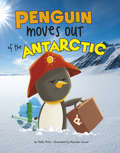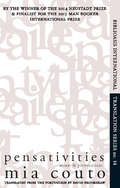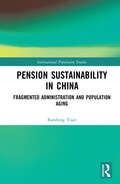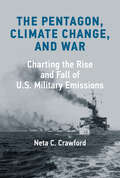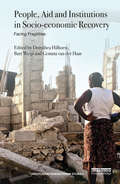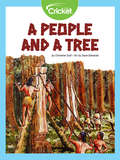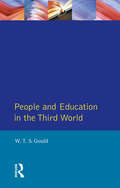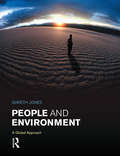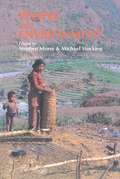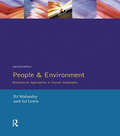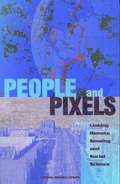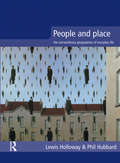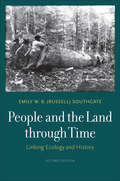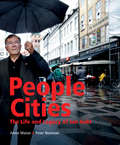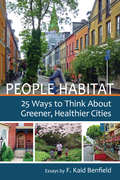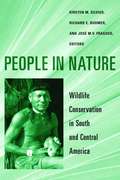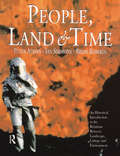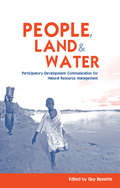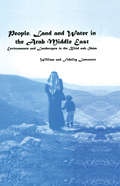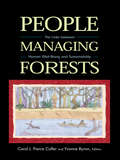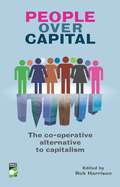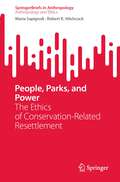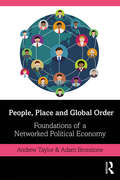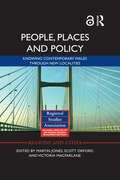- Table View
- List View
Penguin Moves Out of the Antarctic (Habitat Hunter)
by Nikki PottsPenguin is bored with its habitat! Follow Penguin as it tries out different places to live. Which habitat will make the best home for Penguin?
The Penguin of Ilha Grande: From Animal Rescue to Extraordinary Friendship
by Shannon EarleA man rescues a penguin off the coast of Brazil and finds a lifelong connection in this delightful true story about the power of friendship.When an oil-covered penguin washes up in Brazil, Seu João saves the penguin's life. Soon man and penguin are friends, and Dindim the penguin won't return to the wild. At last Dindim swims away, only to return four months later! For seven years, Dindim the penguin lived with Seu João in Brazil for eight months a year, disappearing for four months after his annual molting. Readers will enjoy discovering the wildlife of Brazil while learning about the impacts of oil spills and the importance of conservation. This inspiring, true account of real and unusual friendships is sure to win the hearts of nature and animal lovers alike.
Pensativities
by Mia Couto David Brookshaw"One of the greatest living writers in the Portuguese language."--Philip Graham, The Millions"Subtle and elegant."--The Wall Street Journal"At once deadpan and beguiling."--The Times Literary Supplement"To understand what makes António 'Mia' Emílio Leite Couto special--even extraordinary--we have to loosen our grip on the binary that distinguishes between 'the West' and 'Africa.' Couto is 'white' without not being African, and as an 'African' writer he's one of the most important figures in a global Lusophone literature that stretches across three continents."--The New InquiryWhat would Barack Obama's 2004 campaign have looked like if it unfolded in an African nation? What does it mean to be an African writer today? How do writers and poets from all continents teach us to cross the sertão, the savannah, the barren places where we're forced to walk within ourselves? Bringing together the best pieces from his previously untranslated nonfiction collections, alongside new material presented here for the first time in any language, Pensativities offers English readers a taste of Mia Couto as essayist, lecturer, and journalist--with essays on cosmopolitanism, poverty, culture gaps, conservation, and more.Mia Couto, an environmental biologist from Mozambique, is the author of twenty five books of fiction, nonfiction, and poetry. His work has been translated into twenty languages worldwide. In 2007 he was the first African author to win the Latin Union Award for Romance Languages, in 2013 he was awarded the 100,000 Camões Prize for Literature, and in 2014 he received World Literature Today's $50,000 Neustadt Prize for Literature.
Pension Sustainability in China: Fragmented Administration and Population Aging (International Population Studies)
by Randong YuanPension Sustainability in China: Fragmented Administration and Population Aging aims to investigate the impact of fragmentation and population ageing on pension sustainability in China. The book demonstrates how pension sustainability is compromised by various adverse effects produced by fragmentation, such as the moral hazard caused by the disarticulated intergovernmental fiscal responsibility. An overlapping generations (OLG) model is updated with the latest demographic data and is used to assess the impact of population ageing on pension sustainability. The book considers whether adjustment in retirement age can ensure long-term financial sustainability. It explores how, compared to the population ageing, the issues stemming from the fragmentation pose a more insidious threat to pension sustainability in China.
The Pentagon, Climate Change, and War: Charting the Rise and Fall of U.S. Military Emissions
by Neta C. CrawfordHow the Pentagon became the world&’s largest single greenhouse gas emitter and why it&’s not too late to break the link between national security and fossil fuel consumption.The military has for years (unlike many politicians) acknowledged that climate change is real, creating conditions so extreme that some military officials fear future climate wars. At the same time, the U.S. Department of Defense—military forces and DOD agencies—is the largest single energy consumer in the United States and the world&’s largest institutional greenhouse gas emitter. In this eye-opening book, Neta Crawford traces the U.S. military&’s growing consumption of energy and calls for a reconceptualization of foreign policy and military doctrine. Only such a rethinking, she argues, will break the link between national security and fossil fuels. The Pentagon, Climate Change, and War shows how the U.S. economy and military together have created a deep and long-term cycle of economic growth, fossil fuel use, and dependency. This cycle has shaped U.S. military doctrine and, over the past fifty years, has driven the mission to protect access to Persian Gulf oil. Crawford shows that even as the U.S. military acknowledged and adapted to human-caused climate change, it resisted reporting its own greenhouse gas emissions. Examining the idea of climate change as a &“threat multiplier&” in national security, she argues that the United States faces more risk from climate change than from lost access to Persian Gulf oil—or from most military conflicts. The most effective way to cut military emissions, Crawford suggests provocatively, is to rethink U.S. grand strategy, which would enable the United States to reduce the size and operations of the military.
People, Aid and Institutions in Socio-economic Recovery: Facing Fragilities (Routledge Humanitarian Studies)
by Dorothea Hilhorst Bart Weijs Gemma Van Der HaarAn estimated 2 billion people live in countries affected by fragility, conflict and violence. Extreme poverty is increasingly concentrated in these areas, and governments and international agencies seek avenues to enable socio-economic recovery and to support people as they try to rebuild their lives and livelihoods. People, Aid and Institutions in Socio-economic Recovery: Facing Fragilities provides an in-depth understanding of people’s strategies in the face of conflict and disaster-related fragility and examines how policies and aid interventions enable their socio-economic recovery – or fail to do so. Through field-based research, the book captures the complex and unfolding realities on the ground, exploring the interfaces between economic, social and institutional change. This provides a rich and unique vantage point from which to reflect on the impact of recovery policies. The book provides a set of cross-cutting findings that aim to inform policy and practice. The detailed case studies of the book lay bare key dynamics of recovery. Set against the findings from two chapters that review the literature, the cases provide evidence-based lessons for socio-economic recovery. The chapters combine qualitative and quantitative methodologies and form a valuable resource to researchers and postgraduate students of disaster management, conflict, humanitarian aid and social reconstruction, and development management.
A People and a Tree
by Christine GrafNative American tribes from the Northwest Coast learned to use the wood of cedar trees for many of their daily needs. Tribes used recycling to conserve resources hundreds of years ago. Pounding bark until it was fluffy to make diapers and with special thin branches called withes, cedar trees were soaked and used to make rope. What special technique did tribes use to take down big cedar trees?
People and Education in the Third World (Longman Development Studies)
by W. T. GouldFirst published in 1993. Routledge is an imprint of Taylor & Francis, an informa company.
People and Environment: A Global Approach
by Gareth JonesPeople and Physical Environment, A Global Approach provides an introduction to the main areas of environmental concern for geographers, environmental scientists and planners at the beginning of the twenty-first century. These include:Pollution of the atmosphere and its impact on our climate; The exploitation of the oceans; Management and supply of fresh water; Degradation of the land, and Biodiversity, and the need to maintain genetic diversity.The book argues that our knowledge and understanding of the environment is now so great that we can predict with considerable accuracy where the skills of science and technology need to be focussed in order to prevent severe environmental damage from occurring. Achieving successful management of the environment has become dependent upon active participation of a society prepared to pay for a high quality of life and the willingness of our elected politicians to legislate and enforce the very highest standards of environmental management. This book will be essential reading for students of geography, environmental studies/science and land use planners and will also contribute valuable information for climatology, biogeography, hydrology, land economy and forestry students.
People And Environment: Development For The Future
by Stephen Morse Michael StockingFirst published in 1995. Routledge is an imprint of Taylor & Francis, an informa company.
People and Environment: Behavioural Approaches in Human Geography
by D. J. Walmsley G. J. LewisFirst published in 1994. Routledge is an imprint of Taylor & Francis, an informa company.
PEOPLE and PIXELS: Linking Remote Sensing and Social Science
by Committee on the Human Dimensions of Global ChangeSpace-based sensors are giving us an ever-closer and more comprehensive look at the earth's surface; they also have the potential to tell us about human activity. This volume examines the possibilities for using remote sensing technology to improve understanding of social processes and human-environment interactions. Examples include deforestation and regrowth in Brazil, population-environment interactions in Thailand, ancient and modern rural development in Guatemala, and urbanization in the United States, as well as early warnings of famine and disease outbreaks. The book also provides information on current sources of remotely sensed data and metadata and discusses what is involved in establishing effective collaborative efforts between scientists working with remote sensing technology and those working on social and environmental issues.
People and Place: The Extraordinary Geographies of Everyday Life
by Lewis Holloway Phil HubbardAn innovative introduction to Human Geography, exploring different ways of studying the relationships between people and place, and putting people at the centre of human geography. The book covers behavioural, humanistic and cultural traditions, showing how these can lead to a nuanced understanding of how we relate to our surroundings on a day-to-day basis. The authors also explore how human geography is currently influenced by 'postmodern' ideas stressing difference and diversity. While taking the importance of these different approaches seriously as ways of thinking about the role of place in peoples' everyday lives, the book also tries to encapsulate what has been so vibrant and exciting about human geography over the last couple of decades. By using examples to which students can relate - such as how they imagine and represent their home, the way they avoid certain spaces, how they move through retail spaces, where they choose to go to university, how they use the Internet, how they represent other nations and so on - the authors show how geography shapes everyday life in a manner that is seemingly mundane yet profoundly important.
People and the Land through Time: Linking Ecology and History, Second Edition
by Emily W. SouthgateA revised and updated edition of a classic book that defines the field of historical ecologyPeople and the Land through Time, first published in 1997, remains the only introduction to the field of historical ecology from the perspective of ecology and ecosystem processes. Widely praised for its emphasis on the integration of historical information into scientific analyses, it will be useful to an interdisciplinary audience of students and professionals in ecology, conservation, history, archaeology, geography, and anthropology. This up-to-date second edition addresses current issues in historical ecology such as the proposed geological epoch, the Anthropocene; historical species dispersal and extinction; the impacts of past climatic fluctuations; and trends in sustainability and conservation.
People Cities: The Life and Legacy of Jan Gehl
by Peter Newman Annie Matan"A good city is like a good party--you stay for longer than you plan," says Danish architect Jan Gehl. He believes that good architecture is not about form, but about the interaction between form and life. Over the last 50 years, Gehl has changed the way that we think about architecture and city planning--moving from the Modernist separation of uses to a human-scale approach inviting people to use their cities.At a time when growing numbers are populating cities, planning urban spaces to be humane, safe, and open to all is ever-more critical. With the help of Jan Gehl, we can all become advocates for human-scale design.Jan's research, theories, and strategies have been helping cities to reclaim their public space and recover from the great post-WWII car invasion. His work has influenced public space improvements in over 50 global cities, including New York, London, Moscow, Copenhagen, Melbourne, Sydney, and the authors' hometown of Perth.While much has been written by Jan Gehl about his approach, and by others about his influence, this book tells the inside story of how he learned to study urban spaces and implement his people-centered approach.People Cities discusses the work, theory, life, and influence of Jan Gehl from the perspective of those who have worked with him across the globe. Authors Matan and Newman celebrate Jan's role in changing the urban planning paradigm from an abstract, ideological modernism to a people-focused movement. It is organized around the creation of that movement, using key periods in Jan's working life as a structure.People Cities will inspire anyone who wants to create vibrant, human-scale cities and understand the ideas and work of an architect who has most influenced how we should and can design cities for people.
People Habitat: 25 Ways to Think About Greener, Healthier Cities
by F. Kaid BenfieldWith over 80 percent of Americans now living in cities and suburbs, getting our communities right has never been more important, more complicated, or more fascinating. Longtime sustainability leader Kaid Benfield shares 25 enlightening and entertaining essays about the wondrous ecology of human settlement, and how to make it better for both people and the planet. People Habitat explores topics as diverse as "green" housing developments that are no such thing, the tricky matter of gentrifying inner cities, why people don't walk much anymore, and the relationship between cities and religion. Written with intellect, insight, and from-the-heart candor, each real-world story in People Habitat will make you see our communities in a new light.
People in Nature: Wildlife Conservation in South and Central America
by José Fragoso Kirsten Silvius Richard BodmerThis book reviews wildlife management and conservation in Central and South America. The book discusses the threats to biodiversity in this area including habitat fragmentation, development, ranching, tourism as well as hunting. The book contains contributions from many local Latin American authors who work there daily and are exposed to the numerous and unique issues that need to be taken into account when talking about conservation in Central and South America.
People, Land and Time: An Historical Introduction to the Relations Between Landscape, Culture and Environment
by Brian Roberts Peter Atkins Ian SimmonsThis major new text provides an introduction to the interaction of culture and society with the landscape and environment. It offers a broad-based view of this theme by drawing upon the varied traditions of landscape interpretation, from the traditional cultural geography of scholars such as Carl Sauer to the 'new' cultural geography which has emerged in the 1990s. The book comprises three major, interwoven strands. First, fundamental factors such as environmental change and population pressure are addressed in order to sketch the contextual variables of landscapes production. Second, the evolution of the humanised landscape is discussed in terms of processes such as clearing wood, the impact of agriculture, the creation of urban-industrial complexes, and is also treated in historical periods such as the pre-industrial, the modern and the post-modern. From this we can see the cultural and economic signatures of human societies at different times and places. Finally, examples of landscape types are selected in order to illustrate the ways in which landscape both represents and participates in social change.The authors use a wide range of source material, ranging from place-names and pollen diagrams to literature and heritage monuments. Superbly illustrated throughout, it is essential reading for first-year undergraduates studying historical geography, human geography, cultural geography or landscape history.
People, Land and Water: Participatory Development Communication for Natural Resource Management
by Guy BessetteIn natural resource management research, best practice implies the participation of community members, research or development teams and other stakeholders to jointly identify research and development parameters and contribute to decision making. Ideally, the research or development process itself generates a situation of empowerment in which participants transform their vision and become able to take effective action. Used increasingly widely in resource management, this process is known as Participatory Development Communication (PDC). This book presents conceptual and methodological issues related to the use of PDC to facilitate participation amongst stakeholders in a variety of natural resource management initiatives. Each chapter presents in-depth experiences from Asia and Africa to highlight different ways in which this process can be achieved. The book describes the major issues involved in applying PDC to natural resource management practices and research, discusses the challenges and the difficulties linked to such an approach and offers insights and lessons from research and experience in the field.
People, Land and Water in the Arab Middle East: Environments and Landscapes in the Bilad ash-Sham (Studies in Environmental Anthropology #Vol. 2)
by Fidelity LancasterThe result of twenty-five years of research with different tribal groups in the Arabian peninsula, this study focuses on ethnographic descriptions of Arab tribal societies in five regions of the peninsula, with comparative material from others. Having become aware of the depth in time of Arab tribal structures, the authors have developed a view of Arabic tribal discourse where 'tribe' is seen as essentially an identity that confers access to a social structure and its processes.
People Managing Forests: The Links Between Human Well-Being and Sustainability
by Carol J. Colfer Yvonne ByronHow do we extend the 'conservation ethic' to include the cultural links between local populations and their physical environments? Can considerations of human capital be incorporated into the definition and measurement of sustainability in managed forests? Can forests be managed in a manner that fulfills traditional goals for ecological integrity while also addressing the well-being of its human residents? In this groundbreaking work, an international team of investigators apply a diverse range of social science methods to focus on the interests of the stakeholders living in the most intimate proximity to managed forests. Using examples from North America, Asia, Africa, and Latin America, they explore the overlapping systems that characterize the management of tropical forests. People Managing Forests builds on criteria and indicators first tested by the editors and their colleagues in the mid-1990s. The researchers address topics such as intergenerational access to resources, gender relations and forest utilization, and equity in both forest-rich and forest-poor contexts. A copublication of Resources for the Future (RFF) and the Center for International Forestry Research (CIFOR).
People Over Capital
by Rob HarrisonCapitalism is failing and ordinary people are forced to pay the price. With such deep-rooted problems there is real hunger for alternative ways of organizing our economic system. Answering the question, "Is there a co-operative alternative to capitalism?" this book showcases fourteen responses from economists, academics, co-operators, politicians, and campaigners, exploring both the success and untapped potential of co-operatives. Each essay approaches from a new direction-from the flourishing open source movement to cases of co-operative success in different parts of the world.Rob Harrison has written and commented widely on social change issues for more than twenty years.
People, Parks, and Power: The Ethics of Conservation-Related Resettlement (SpringerBriefs in Anthropology)
by Maria Sapignoli Robert K. HitchcockThis book presents a critical review of the ethics of conservation-related resettlement. We examine what has become known as the” parks versus people” debate, also known as the “new conservation debate,” which has pitted indigenous and other local people against nation states and social scientists against ecologists and conservationists for the past several decades. Aiming to promote biodiversity conservation and habitat preservation, some biologists, park planners, and conservation organizations have recommended that indigenous and other people should be removed from protected areas. Local people, for their part, have argued that residents of the areas that were turned into protected areas, national parks, game reserves and monuments had managed them in productive ways for generations and that they should have the right to remain there and to use natural resources as long as they do so sustainably. This position is often supported by indigenous rights organizations and social scientists, especially anthropologists. There are also some conservation-oriented NGOs that have policies involving a more human rights-oriented approach aimed at poverty alleviation, sustainable development, and social justice. The book discusses biodiversity conservation, indigenous peoples (those who are ethnic minorities and who are often marginalized politically), and protected areas, those categories of land set aside by nation-states that have various kinds of rules about land use and residence. The focus initially is on case studies from protected areas in the United States including Yellowstone National Park, Yosemite National Park, and Glacier National Park and on national monuments and historical parks where resettlement took place. We then consider issues of coercive conservation in southern Africa, including Hwange National Park (Zimbabwe), the Central Kalahari Game Reserve (Botswana), Etosha National Park, and Bwabwata National Park (Namibia), and Kgalagadi Transfrontier Park (South Africa and Botswana). All of these cases involved involuntary resettlement at the hands of the governments. In the book we consider some of the social impacts of conservation-forced resettlement (CfR), many of which tend to be negative. After that, we assess some of the strategies employed by indigenous peoples in their efforts to recover rights of access to protected areas and the cultural and natural resources that they contain. Examples are drawn from cases in Asia, Africa, and South America. Conclusions are provided regarding the ethics of conservation-related resettlement and some of the best practices that could be followed, particularly with regard to indigenous peoples.
People, Place and Global Order: Foundations of a Networked Political Economy
by Andrew Taylor Adam BronstoneGlobalization and technology are combining to change socio-economic relationships. The pace of change and uncertainty of the world of work – no job for life, zero-hours contracts, diminished pension rights and a growing delivery dependence on digital networks over human contact – are creating a profound unease that may be unprecedented in the Western world. If organizational patterns are not sufficiently adjusted and businesses continue as usual, we run the risk of alienating entire groups within society with many feeling ‘left behind’. Using deliberately accessible language for students and the general reader, the authors draw upon socially innovative models of economic organization from the nineteenth century to present a model to master this new economy for the common good. The book illustrates, with practical examples, how digital networks can be leveraged and provides a common checklist to identify suitable conditions for organizations to flourish and provide the means to more effectively evaluate opportunities.
People, Places and Policy: Knowing contemporary Wales through new localities (Regions and Cities)
by Martin Jones Scott Orford Victoria MacfarlaneThe Open Access version of this book, available at www.tandfebooks.com, has been made available under a Creative Commons Attribution-Non Commercial-No Derivatives 3.0 license. Set within the context of UK devolution and constitutional change, People, Places and Policy offers important and interesting insights into ‘place-making’ and ‘locality-making’ in contemporary Wales. Combining policy research with policy-maker and stakeholder interviews at various spatial scales (local, regional, national), it examines the historical processes and working practices that have produced the complex political geography of Wales. This book looks at the economic, social and political geographies of Wales, which in the context of devolution and public service governance are hotly debated. It offers a novel ‘new localities’ theoretical framework for capturing the dynamics of locality-making, to go beyond the obsession with boundaries and coterminous geographies expressed by policy-makers and politicians. Three localities – Heads of the Valleys (north of Cardiff), central and west coast regions (Ceredigion, Pembrokeshire and the former district of Montgomeryshire in Powys) and the A55 corridor (from Wrexham to Holyhead) – are discussed in detail to illustrate this and also reveal the geographical tensions of devolution in contemporary Wales. This book is an original statement on the making of contemporary Wales from the Wales Institute of Social and Economic Research, Data and Methods (WISERD) researchers. It deploys a novel ‘new localities’ theoretical framework and innovative mapping techniques to represent spatial patterns in data. This allows the timely uncovering of both unbounded and fuzzy relational policy geographies, and the more bounded administrative concerns, which come together to produce and reproduce over time Wales’ regional geography.
